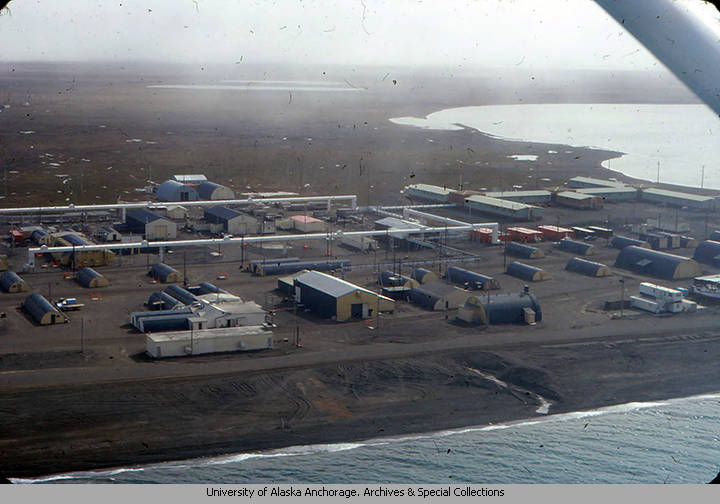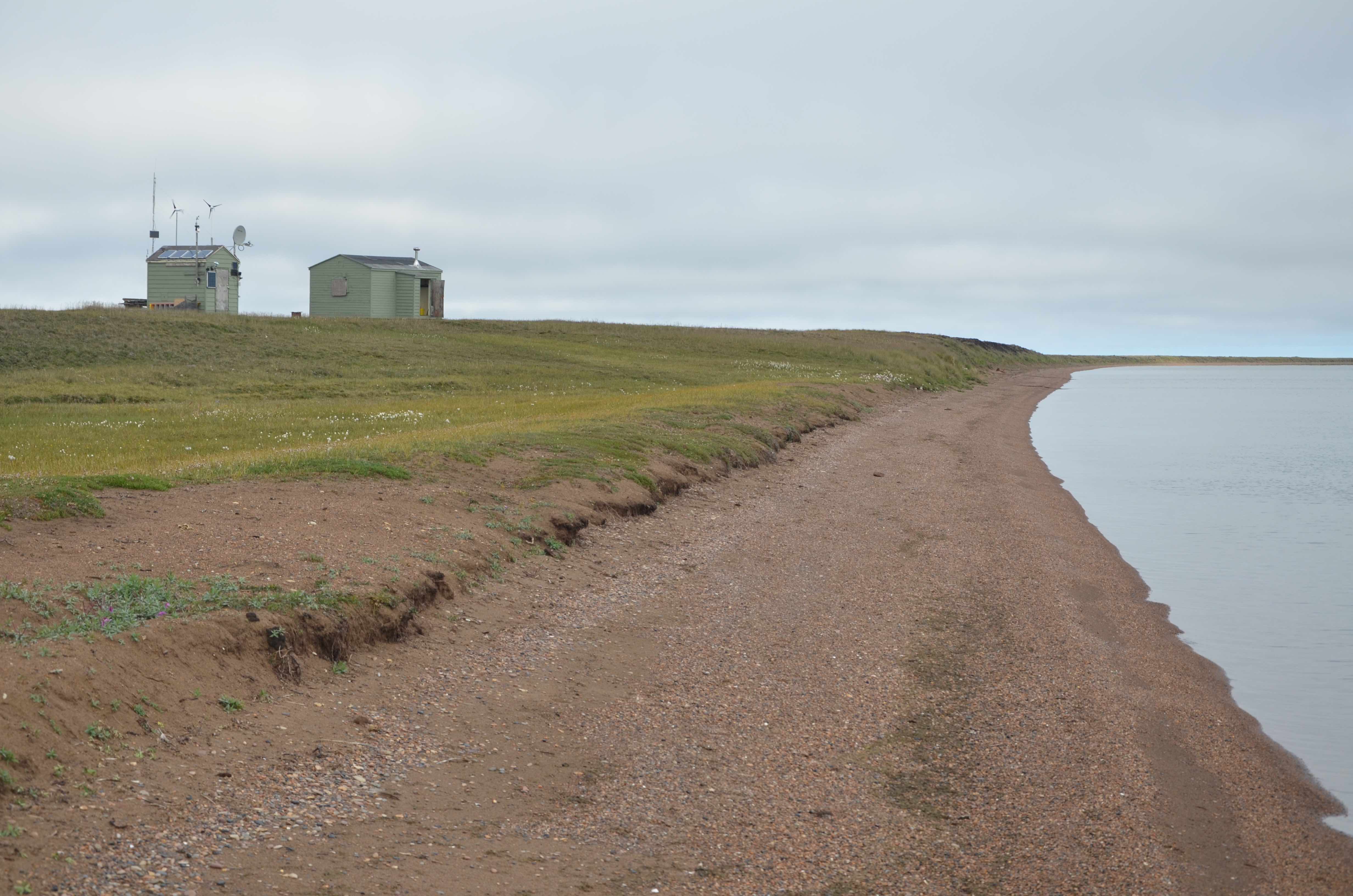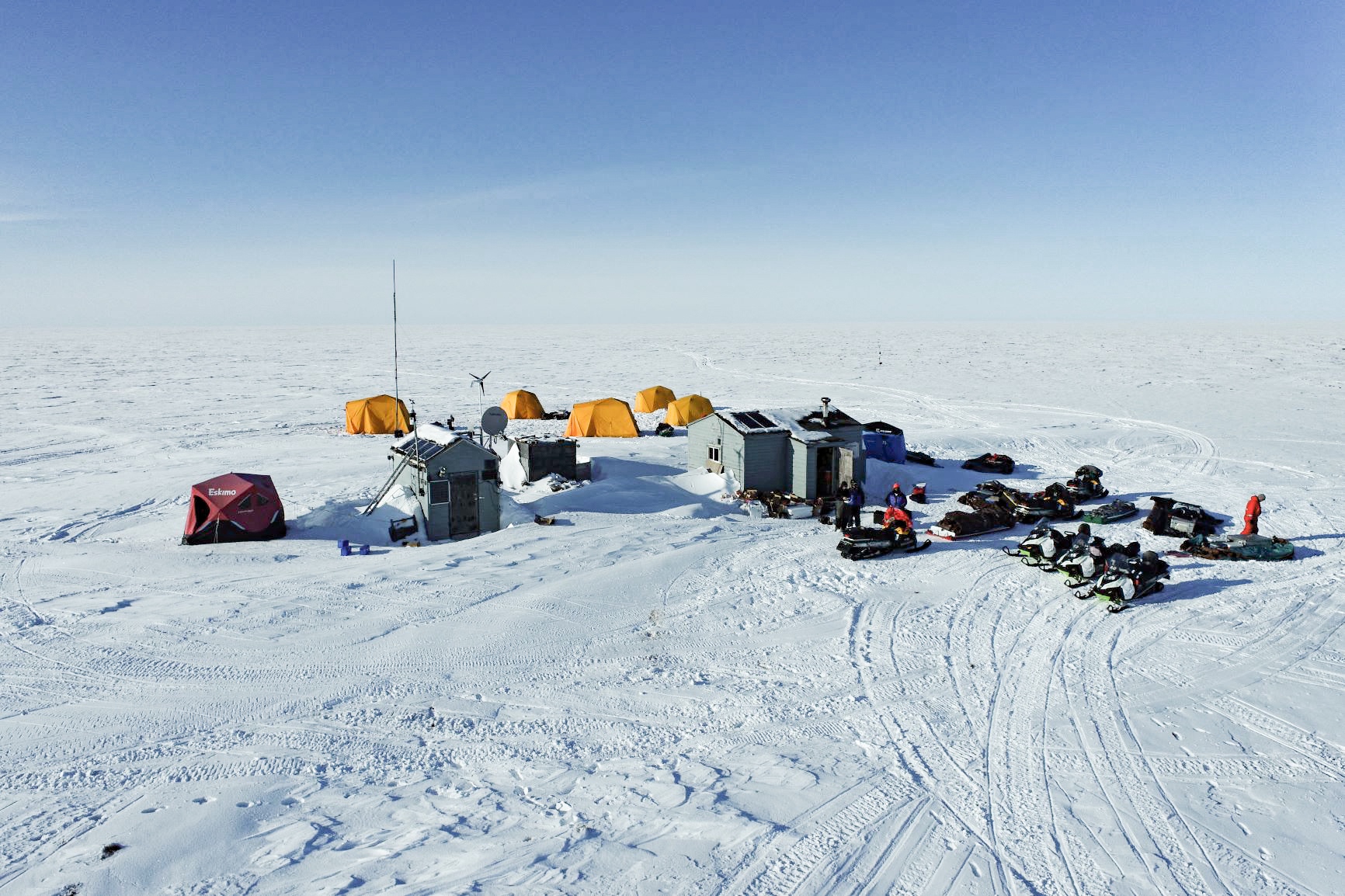A grateful scientist celebrates an Arctic lab’s pioneers
Rod Boyce
907-474-7185
Sept. 9, 2022
For Ben Jones, putting together an event to celebrate the 75th anniversary of the founding of the Naval Arctic Research Laboratory was personal.
The lab at Utqiagvik, at the northern tip of Alaska, has changed since its beginnings. It now operates under a different name and with a different owner and operator, Ukpeaġvik Iñupiat Corporation and subsidiary UIC Science.
But the legacy of the original lab reaches Jones and others to this day.

The Naval Arctic Research Laboratory is seen from the air in July 1980 as part of a community tour of the facility.
“To really understand where you've come from and where your discipline has emerged from, you’ve got to step back and look at the late 1940s when the lab was established,” said Jones, a research assistant professor at the University of Alaska Fairbanks Institute of Northern Engineering.
“The lab really paved the way for nearly all of the research that's happened up there since then,” he said. “I feel like my career has truly benefited from the history and legacy of the lab in the community and across the region.”
Jones said obtaining funding from the National Science Foundation for the August anniversary event and helping to organize it and the concurrent Enhancing Arctic Science and Engineering Workshop provided a way for him to acknowledge the history from which his research was born.
“I've been working in Utqiagvik and across the broader North Slope region for more than 20 years, so I feel very familiar and comfortable with that environment in terms of my research focus and efforts,” he said.
•••
The anniversary event drew leaders in Arctic science, university representatives, local officials and others to Utqiagvik in early August for a weeklong event that was a celebration of the past and a look at the potential for the years ahead.
UAF representatives included Vice Chancellor for Research Nettie LaBelle-Hamer; Hajo Eicken, director of the International Arctic Research Center; Jeremy Kasper, interim director of the Alaska Center for Energy and Power; Diane O'Brien, interim director of the UAF Institute of Arctic Biology; UAF Emeritus Professor Carl Benson, whose research about the McCall Glacier and about seasonal North Slope snowfall were based at NARL.

Melissa Ward Jones, Lillian Jones, Kaya, and Benjamin Jones (left to right) doing family science at the Teshekpuk Lake Observatory during the summer of 2021.
Others included Matthew Sturm, Geophysical Institute geophysics professor and snow expert; Anne Jensen, affiliate research assistant in the Department of Anthropology; Brendan Kelly, chief scientist, Study of Environmental Arctic Change; Andy Mahoney, sea ice geophysicist; Roberta Glenn, who recently completed her master’s degree, Daphne Mueller, graduate student; Kimberly Pikok, graduate student; and Garrett Taylor, undergraduate student.
U.S. government representatives came from the National Science Foundation, the National Oceanic and Atmospheric Administration, U.S. Arctic Research Commission, Department of Energy’s Arctic Energy Office and Office of Science, Sandia National Lab, Pacific Northwest National Lab and Lawrence Livermore National Lab.
Participants assessed past research and discussed the potential for the next 25 years in a wide array of subjects. Topics included terrestrial vegetation, freshwater ecology, marine and terrestrial wildlife, social sciences, atmosphere and climate, the cryosphere, biogeochemistry, marine and coastal processes and long-term environmental observation and monitoring.
Representatives of the Department of Defense, which has an increasing interest in the Arctic, gave the defense perspective on the future of Arctic research.
Key people who assisted Jones in organizing the celebration include Nagruk Harcharek of UIC, Erika Green of Umiaq Environmental, Kristina Baiborodova of Arktika Company and Jana Peirce of UAF.
A highlight of the celebration was the UIC Science announcement of the inaugural Kenneth Toovak & Max Brewer Memorial Research Award for graduate students and postdoc researchers. The award provides recipients free logistical support for field research.
“The mission of UIC Science, our beliefs and Iñupiaq values, and our sustained support for science motivates us to establish a new initiative that will foster linkages between next-generation scientists and our community,” the announcement reads.
Historian Karen Brewster of the North Slope Borough’s Iñupiat History, Language & Culture Division, wrote about Brewer and Toovak in a 1997 article titled “Native Contributions to Arctic Science at Barrow, Alaska.”
Brewer became the lab’s first year-round, on-site director in 1956. He served in that role until 1971. He died in 2012.
Brewster writes that Brewer is well regarded for the opportunities he provided the Iñupiat while director. He hired many for work with the lab and with visiting researchers and would send them into the field with the scientists.
Brewer was born in Blackfalds, Alberta, and first came to Alaska in 1948 to conduct summer field research in Fairbanks for the U.S. Geological Survey. He moved to Utqiagvik, then known as Barrow, two years later to conduct permafrost research at the lab for the USGS.
Toovak, born in Barrow, worked at the lab for more than 20 years and died in 2009. He is one of only two Iñupiat to receive recognition from the Sigma XI Scientific Research Honor Society for nonprofessional scientists who have aided scientific research.
“Kenneth knew how to accomplish anything that had to be done,” Brewer said in a 1996 interview. “He’d never taken mechanics in college — and by that I mean applied mechanics. But whereas in college they don’t teach you how to use leverage or to innovatively apply it in the field, Kenneth was and is the master in the application of mechanics.”
Brewer and Toovak each received an honorary doctorate from the University of Alaska.
•••
The work of Brewer, Toovak and so many others in the early years is what Jones and so many others stand on today.
“The lab is the foundation for Arctic research,” Jones said. “Even though NARL doesn’t exist anymore, the current lab is a nice example of working with a community, relying on local observations, traditional knowledge and bringing that into Western science.

The rehabilitated Old NARL cabin on the northwestern shores of Teshekpuk Lake that serves as the base for the observatory.
“I’ve definitely benefited from that presence,” he said. “I’ve traveled the tundra with a lot of local Iñupiaq.”
Jones’ Alaska research story and his eventual physical tie to the Naval Arctic Research Laboratory begins in 2001 in Utqiagvik — Barrow at the time — as a University of Cincinnati undergraduate student funded through the NSF’s Research Experience for Undergraduates program. He was working mostly in and around the NARL facilities in town and the Barrow Environmental Observatory.
“My fieldwork was local in my first couple of years, but then I started working on a project that got me further afield,” he said.
After a brief exchange with now-retired North Slope Borough Department of Wildlife biologist Craig George in the halls of Building 360 at NARL, he came across a map of camps and cabins and saw one labeled as the “old NARL cabin” at the northwest corner of Teshekpuk Lake.
One day in 2003 or 2004, he can’t remember what year, he and others were returning to Barrow from studying lakes and basins of drained lakes north of Teshekpuk Lake. He saw the old cabin.
“It was just sitting there, boarded up and abandoned, so I started asking questions about it,” he said.

The remodeled kitchen and lab-bench space inside the Old NARL cabin at the Teshekpuk Lake Observatory.
He contacted Max Brewer, the Arctic Research Laboratory’s director from 1956 to 1971. He would know about the old cabin.
“His vision was this distributed network of research stations across the North Slope where there would be a cabin and a generator shed,” Jones said, “and all people would have to do is show up with their food and their sleeping bags. Then they could just start doing research in remote locations.”
The old cabin became Jones’ project. In 2007 he walked into the cabin for the first time.
“With the encouragement of Max and Kenny Toovak, I started to fix it up and rehabilitate it as a remote Arctic field station,” he said.
“Since that time I've probably brought out upward of 60 Arctic researchers from all around the world to do research there,” he said. “We've had at least a dozen students work on parts of their master’s or Ph.D. theses out of the old cabin.”

A drone photo of the Teshekpuk Lake Observatory taken during a spring snowmachine traverse in 2022 that included researchers from Germany, Japan, Brazil and the United States.
The cabin is now an official UAF research station, permitted through the U.S. Bureau of Land Management. Jones has spent more than one year of his life in the cabin over the last 15 years.
That cabin, other remote North Slope research outposts and the Utqiagvik laboratory complex all make possible Jones’ research of Arctic and sub-Arctic landscape change and the processes that drive it. He does it through remote sensing, GIS, field observations and lab analysis.
His current research focuses on Arctic lakes — how they change over time and what happens when they drain. He is also working with Ken Tape of the Geophysical Institute’s Snow, Ice & Permafrost Group to study how the northward progression of beavers affects the environment.
And it all goes back to an effort in the late 1940s to capitalize on the Navy’s exploration of what was then called Naval Petroleum Reserve No. 4. The Navy had set up a camp at the northern tip of Alaska that could provide the logistical support for a laboratory.
“The founding of the lab and its presence in the region still leaves a lasting impression on people,” Jones said. “The Arctic Research Lab paved the way for all high-latitude research.”
Rod Boyce is a science communicator in the UAF Geophysical Institute’s Public Information Office.


